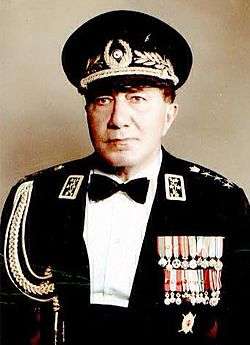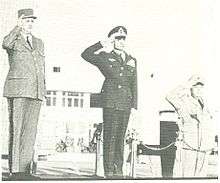Bahram Aryana
Arteshbod Bahram Aryana (Persian: بهرام آریانا); also known as Bahram Ariana born Hossein Manouchehri;[3] 17 March 1906 – 21 June 1985)[4] was a top Iranian military commander during the reign of Mohammed Reza Pahlavi as well as a philosopher of Zoroastrianism, Persian nationalist and humanist.
Bahram Aryana | |
|---|---|
 General Bahram Aryana | |
| Born | Hossein Manoochehri 17 March 1906 |
| Died | 21 June 1985 (aged 79) |
| Burial place | Montparnasse Cemetery |
| Nationality | Iranian Georgian |
| Occupation | |
| Organization | Azadegan Organization |
| Title | Military attaché of Iran to France and Benelux[1] |
| Term | 1952–1953 |
| Political party | |
| Academic background | |
| Fields | |
| Alma mater | |
| Thesis | Napoleon et l'Orient (1955) |
| Institutions | Officers' Academy[2] |
| Works | Pour une ethique iranienne (1981) |
| Military career | |
| Allegiance | |
| Service/ | Ground Forces |
| Years of service | 1930–1979 |
| Rank | Arteshbod |
| Commands held | Imperial Iranian Ground Force Imperial Guard |
| Awards | Legion of Honour |
Professor Monica M. Ringer has described Aryana as probably the most notorious “converted Zoroastrian” of the Pahlavi era.[5]
Biography
He was born on 17 March 1906 in Tehran[6] from a Georgian mother,[7] whose ancestor was King Heraclius II, and from a judge father, Sadr-ed-din.[6] His name was Hossein Manouchehri, which he would change it to Bahram Aryana in 1950.[6] He was educated in France at the École Supérieur de Guerre and received his PhD in 1955 from the Faculty of Law of Paris with his thesis "Napoleon et l'Orient" (published in 1957). Aryana is known to have styled himself on Napoleon and dressed in the Imperial French style.[8]
After the Anglo-Soviet invasion of Iran in 1941 during World War II, he went on with armed struggle and resisted the occupation before being arrested by the British forces. He was instrumental in many of the nationalist policies in the 1950-1960s. During the military campaign of 1964-65 he successfully pacified rebellious tribes in the south of Iran (Pars, Isfahan and Khuzestan) stirred-up by Ayatollah Ruhollah Khomeini, without shedding blood.

Following his military success in the south, General Aryana was named Chief of Staff of the Shah's Army, position he maintained from 1965 to 1969.
During his posting as Chief of Staff, he met with various head of states including Richard Nixon, who received him at the White House, Yitzhak Rabin (then the Chief of Staff of the Israel Defense Forces, who received him in Israel and General de Gaulle, during his visit to Iran.
Aryana left Iran in 1969 on the order of the Shah.[6] This was due to the Arvand Rud (Shatt al-Arab) crisis.[9] Brian Murphy has described Aryana as a flawed tactician, noting his failure to quell the Qashqai revolts, strategic blunders and his 'insatiable appetites for booze and high-class prostitutes'. [10]
He died in exile in Paris in June 1985[11] and is buried at the Montparnasse cemetery. General Aryana was a Grand Officier of the French Legion of Honour.[12]
His last published book, Pour une Éthique Iranienne was a call for unity against the obscurantist forces driving Khomeini and the mullahs' fundamentalist revolution.[13]
Party affiliation
Aryana described himself as being an Iranian nationalist and moderate socialist, not a monarchist. Although he received a great deal of support from monarchists who considered him to be a supporter.[14] Aryana held dual membership of Aria Party and SUMKA.[15]
He founded Azadegan,[16] a nationalist opposition group which had "developed a full command staff structure and support from all nationalist elements from the moderate left to the monarchists".[17] while in exile in Paris.
Azadegan, meaning Born Free, was an anti-Khomeini movement which claimed as many as 12,000 followers in Iran, many of them in the armed forces.[11]
The daring seizing by Azadegan's officers of Tabarzin, an Iranian Navy's Combattante II class fast attack craft just built by France and en route to Iran while in the Mediterranean in August 1981, attracted media attention to Azadegan and its members' armed resistance against the clerical regime of Iran.[18][19]
References
- Nīshābūrī, Naṣr Allāh Tavakkulī (2014). Memoirs of Nasrollah Tavakoli, The First Chief of Staff of the Iranian Army after the Islamic Revolution (in Persian). Ibex Pub. pp. 351–352. ISBN 978-1588140982. Retrieved 5 November 2017.
- "Who was Aryana" (in Persian). Political Studies and Research Institute. Retrieved 5 November 2017.
- Ali Akbar Dareini (1998). The Rise and Fall of the Pahlavi Dynasty: Memoirs of Former General Hussein Fardust. Motilal Banarsidass Publ. pp. 15–16. ISBN 8120816420.
- "Biographie du Général Bahram ARYANA" (in French). Aryana2500.fr. Retrieved 13 April 2017.
- Ringer, Monica M. (2012). "Iranian Nationalism and Zoroastrian Identity". In Amanat, Abbas; Vejdani, Farzin (eds.). Iran Facing Others. Iran Facing Others: Identity Boundaries in a Historical Perspective. Palgrave Macmillan US. pp. 267–277. doi:10.1057/9781137013408_13. ISBN 978-1-137-01340-8.
- "Iranian Personalities. General Bahram Ariana". Iran Chamber Society. Retrieved 4 January 2016.
- Rezvani, Babak (Winter 2009). "The Fereydani Georgian Representation". Anthropology of the Middle East. 4 (2): 57. doi:10.3167/ame.2009.040205.
- Murphy, Brian (4 August 2006). The Root of Wild Madder: Chasing the History, Mystery, and Lore of the Persian Carpet. Simon and Schuster. ISBN 978-0-7432-6421-1.
- "Papers of General Fereydoun Djam - Archives Hub". archiveshub.jisc.ac.uk. Retrieved 29 December 2019.
- Murphy, Brian (4 August 2006). The Root of Wild Madder: Chasing the History, Mystery, and Lore of the Persian Carpet. Simon and Schuster. ISBN 978-0-7432-6421-1.
- Bahram Aryana Dies; Ex-Iran Chief of Staff New York Times.(Paris). 27 June 1985. Retrieved 4 January 2015.
- List of foreign recipients of the Légion d'Honneur
- "Pour une Ethique Iranienne". Archived from the original on 25 September 2013. Retrieved 30 August 2017.
- Ap (27 June 1985). "Bahram Aryana Dies; Ex-Iran Chief of Staff". The New York Times. ISSN 0362-4331. Retrieved 29 December 2019.
- Rahnema, Ali (24 November 2014). Behind the 1953 Coup in Iran: Thugs, Turncoats, Soldiers, and Spooks. Cambridge University Press. p. 55. ISBN 978-1107076068.
- Anoushiravan Ehteshami (1995). After Khomeini: the Iranian Second Republic. Psychology Press. p. 15. ISBN 978-0-415-10879-9. Retrieved 13 March 2011.
- Defense & Foreign Affairs, February 1981
- FRANK J. PRIAL (19 August 1981). "Iranian Hijackers Sail To Marseilles". The New York Times. Iran; Marseilles (France); France. Retrieved 13 April 2017.
- "Iran Exiles Plan New Military Acts". The New York Times. Reuters. 22 August 1981. Retrieved 13 April 2017.